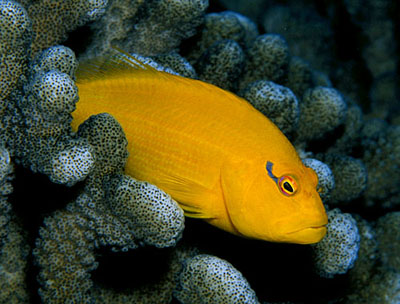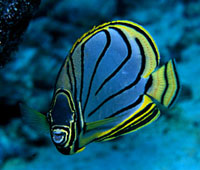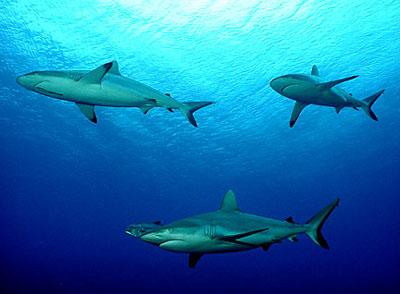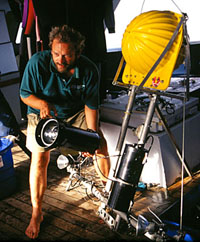|
|
|
(story continued from page 1)
 |
|
Yellow hawkfish perch throughout the hard corals
(c) Mary Jane Adams
|
"...more than an ocean, the Pacific is like a universe, and a chart of it looks like a portrait of the night sky... an immensity of emptiness, dotted with misshapen islands that twinkle like stars"
Paul Theroux, The Happy Isles of Oceania
It all started with a familiar lament and a vanished pilot. Rob and I have an adventurous friend, video producer, Kandy Kendall, who admitted that she yearned for some raw remote diving but that every location seemed explored already.
"Jacques Cousteau, Stan Waterman, Hans Hass - they pioneered all the great destinations. What is left for our generation to claim? Where can we go?"
Rob and I turned to each other and smiled - a metaphoric light bulb glowing over our heads. Rob whipped out the Central Pacific Ocean chart and circled a small cluster of dots in the middle of nowhere called the Phoenix Group. One of the eight islands, Nikumaroro, was an atoll we had visited with NAI'A twice previously as part of The International Group for Historic Aircraft Recovery (TIGHAR) quest for the remains of the world's most famously disappeared aviator, Amelia Earhart. TIGHAR believe Earhart successfully landed on Nikumaroro and perished there. An early TIGHAR expedition to Nikumaroro had included some underwater searches and, despite a sport diving prohibition on later TIGHAR journeys there, Rob and I had sneaked a couple of sensational hours underwater while setting moorings. We did not find Amelia but we vowed one day to return to explore the other islands for great diving. Kandy was now vowing to join us and sponsor an expedition there.
|
|
| We searched and discovered that, other than those few TIGHAR divers in 1989, no one had dived Nikumaroro and the only other diving in the Phoenix group had been done at Aba-Riringa in the early 70s by some Waikiki Aquarium biologists. While Smithsonian ornithologists surveyed bird populations on a few of the Phoenix atolls in 1964 and 1975, the only other marine research was a census of fish netted in 1939 by Smithsonian ichthyologist, Leonard Schultz. In Phoenix, we had ourselves one of Herman Melville's "milky-ways of coral isles, low-lying, endless, unknown Archipelagoes" almost entirely uninhabited and with the promise of untold underwater treasures. |
 |
|
Butterflyfish were varied and numerous in massive schools
(c) Mary Jane Adams
|
Dr David Obura - Rapid Site Assessment & Coral Biology
I never imagined a coral landscape like Aba-Riringa's lagoon could exist. Coral hills and valleys built from table and staghorn corals. Riding the tidal current is like flying a jet through craggy mountain passes, dodging bombardment by titan triggerfish and coral-eating buttterflyfish. Craters in the sand interrupt expanses of shy garden eels and attest to the abundance of clams - and rays that feed upon them.
|
|
|
| The Phoenix Islands lie more than 1000 nautical miles northeast of Fiji and within the long stretch of equatorial Pacific Ocean territory claimed by the Republic of Kiribati (pronounced kitty-bus). Although Kiribati earns significant income from selling international fishing licenses and such a remote location could hardly be considered safe from illegal fishing, one thing gave Phoenix enormous possibility: a lack of human settlement. Tropical atolls may look idyllic from a distance and romantic in our collective consciousness. But in fact they are harsh hostile places, bleak and forbidding beyond the fringing palm trees, without life-sustaining fresh water and ceaselessly exposed to the wrathful intensity of the open ocean. Guano miners and copra harvesters left their mark on the islands briefly in the early 1800s. Settlers from the overcrowded Gilbert and Ellice Islands attempted a new life on three of the Phoenix Islands in 1938 but the British colonial scheme was all but abandoned early in the 40s. The final few desperate and determined villagers were evacuated in 1963. Only Aba-Riringa has any inhabitants now: less than 40 people from eight families assigned to the desolate strip of scrub-covered coral in a care-taking role for the Kiribati government. The really stimulating and hectic years on Aba-Riringa are those during which more than two sailing boats pull in to the lagoon to rest. |
 |
|
Grey reef shark schools greeted us at the start of every dive
(c) Cat Holloway, NAI'A
|
Everywhere nowadays there is terrifying evidence that coral reefs (as we know them, at least) are dying. Marine life is disappearing faster than we can even identify, let alone understand it. For us, Kandy, and the other sponsors who signed on for this expedition, just going diving wasn't enough. We all wanted to learn as much as we could and make the journey as meaningful as possible to the rest of the world. We called the expedition Phoenix Rising, reflecting on the eternal cycle of death and rebirth symbolized by the mythical Egyptian bird, the Phoenix, who rises again from its own ashes just as coral builds and blooms on the skeletons of old reefs - for all eternity, we hope.
|
| We dreamed that in Phoenix we would find a pristine place free from the disease, pollution and abuse cloaking our seas in doom. And we shared a grander ideal: that we might actually find a wilderness worth saving. We needed grass-roots science to ascertain Phoenix's importance and then strategy to encourage preservation. For this we turned to another friend, Dr Gregory Stone, the Director of Conservation at the New England Aquarium. Greg and his wife, Austen Yoshinaga, are ardent field biologists and were immediately inspired to make the Phoenix Rising Expedition the first in the New England Aquarium's Primal Ocean Project: a quest to identify, document and protect the planet's final unblemished underwater frontiers. |
 |
|
Dr Greg Stone readies the deepwater 'ropecam'
(c) Mary Jane Adams
|
|
|
According to Greg: "There are just a few isolated places left on this planet where we have any hope of seeing ocean environments in pre-historic rawness, free of the destruction of development and over-fishing."
|
|
(story continued on page 3)
1 - 2 - Next Page - 4 |
|
|